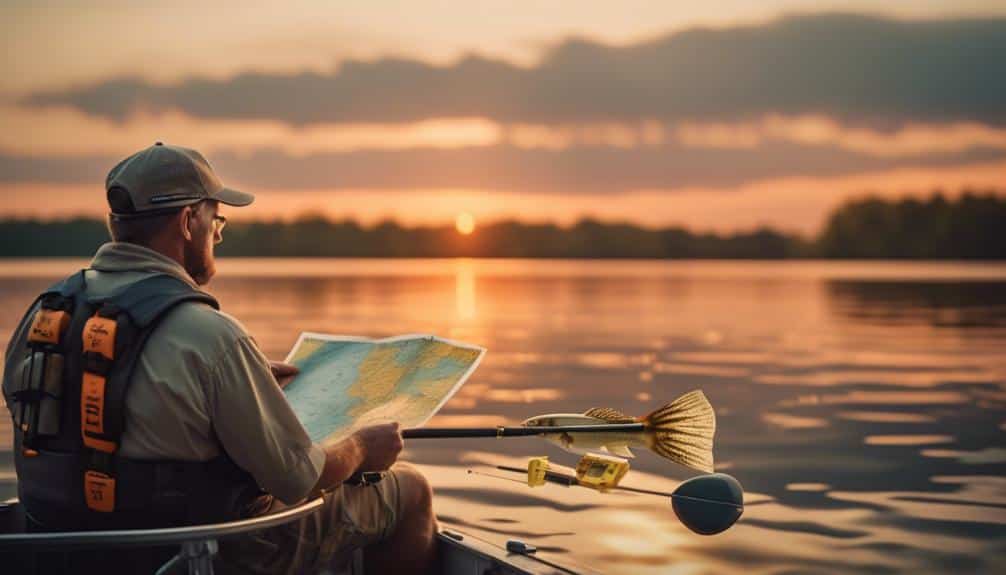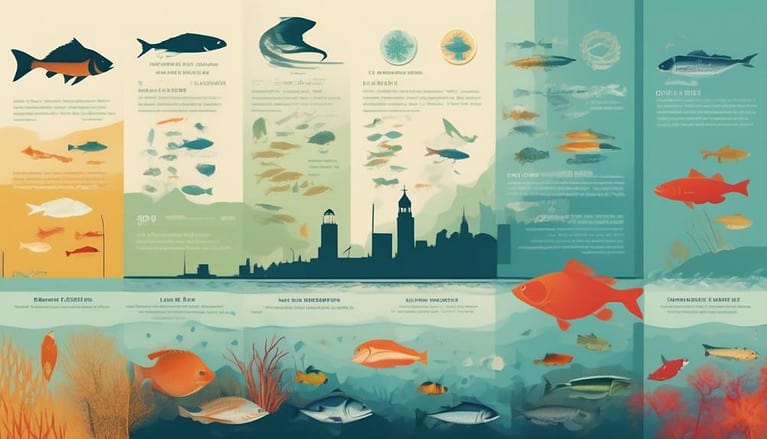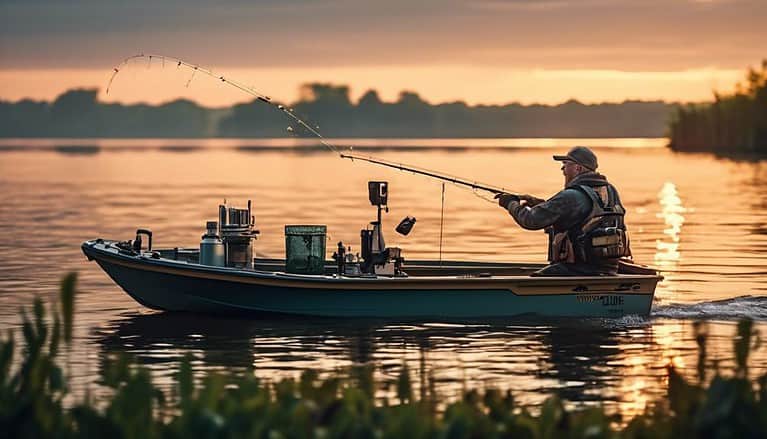Walleye Fishing in Lake Erie: Tips & Strategies for Success” to incorporate keywords more naturally

In an era where smartphones and digital maps have largely replaced compasses and paper charts, you’ll find that mastering the art of walleye fishing in Lake Erie demands more than just a modern gadget can offer. It’s about blending the rich knowledge of past generations with today’s technological advancements to truly understand the dance of walleye beneath the waves.
You’ve likely heard that Lake Erie’s waters are teeming with these elusive fish, but cracking the code to consistently landing them requires a mix of science, instinct, and a touch of old-fashioned patience. This journey into walleye wisdom isn’t just about what bait to use or the perfect time of day; it’s an invitation to align with the rhythm of nature herself.
So, if you’re ready to elevate your angling game and connect with the storied tradition of fishing in these waters, you’ll want to keep exploring. The secrets awaiting could transform your experience from occasional luck to predictable success.
Key Takeaways
- Walleye migration in Lake Erie significantly impacts their location and feeding patterns.
- Adapting fishing tactics to the changing seasons enhances the chances of success in catching Walleye.
- Trolling with planer boards and jigging are effective fishing techniques for targeting Walleye.
- Port Clinton, South Bass Island, Ashtabula, Geneva, and the Trenches are prime fishing locations in Lake Erie.
Understanding Walleye Behavior

Why do Walleye migrate, and how does this behavior influence their location and feeding patterns in Lake Erie?
Walleye, a migratory species, embark on this journey primarily for spawning in the early spring, seeking out gravelly or sandy shores. This migration not only fulfills their reproductive needs but also leads them to areas with optimal water temperatures and abundant food sources post-spawning. Consequently, their migration patterns significantly affect where and how you can maximize your chances of catching Walleye in Lake Erie.
Understanding the depths at which Walleye can be found, ranging from 5 to 60 feet, is crucial for any angler. Their constant search for food, driven by their rapid growth demands, makes them more predictable if you know where to look.
This is where the expertise of professional anglers and local guides becomes invaluable. They can navigate the vast expanses of Lake Erie, employing the right fishing equipment to target Walleye effectively. Whether you’re interested in traditional fishing or ice fishing, knowing Walleye’s behavior and their preferred habitats will significantly enhance your fishing expeditions.
Seasonal Fishing Strategies

Building on the understanding of Walleye behavior, let’s explore how their migratory patterns shape effective seasonal fishing strategies in Lake Erie. As a successful angler, you’re aware that Walleye Fishing in this vast lake requires adapting your approach with the changing seasons, leveraging scientific insights into their habits.
In spring, Walleye migrate towards shallow waters to spawn, making this the optimal time for using lighter fishing rods and live bait to mimic their natural prey. This period demands precision in your casting technique to reach the areas where Walleyes are most abundant.
Summer brings a different challenge; Walleye move to deeper, cooler parts of Lake Erie. Here, mastering the use of weighted lines and diving lures becomes crucial. Developing new tactics that consider the thermocline and water temperature can significantly increase your chances of Catching Fish.
Come fall, Walleye tend to feed aggressively in preparation for winter, moving closer to shore again. This is when experimenting with a variety of live baits can yield impressive results, as Walleye are less discerning but more competitive.
Understanding these seasonal fishing strategies is key in Lake Erie. It’s not just about knowing where the Walleye are, but also how to effectively lure them across different seasons.
Effective Fishing Techniques

To maximize your success in catching Walleye in Lake Erie, it’s essential to master a variety of fishing techniques, each tailored to the fish’s unique behaviors and the lake’s diverse environments. Over the years, anglers have developed effective fishing techniques that leverage scientific insights into Walleye behavior, offering a higher chance of success for those fishing on Lake Erie, a jewel among the Great Lakes.
Trolling with planer boards allows you to cover vast areas of water efficiently, presenting your lures at various depths where Walleye are most likely to be hunting. This technique capitalizes on the Walleye’s predatory patterns, particularly during their peak feeding times. Precision in depth control, informed by understanding the seasonal migrations of Walleye within the lake’s complex structure, is critical.
Jigging, another effective technique, involves a more stationary approach but requires an intimate knowledge of the lake’s bottom contour and the ability to detect subtle bites. The scientific approach here involves using sonar technology to locate fish and structure, then presenting a jig in a manner that mimics natural prey movements. This method, grounded in Walleye Wisdom, harnesses the fish’s instinctual responses, making it a potent tactic for anglers seeking to master fishing on Lake Erie.
Prime Fishing Locations

Identifying prime fishing locations in Lake Erie, such as Port Clinton and South Bass Island, significantly enhances your chances of landing Walleye, given the lake’s varied topographical and ecological zones. Delving deeper, areas like Ashtabula, Geneva, and the Trenches also stand out for their exceptional Walleye yield.
Decades ago, astute tournament anglers on the tournament trail discovered that Lake Erie’s Western Basin excels in productivity, especially in the spawning season. Conversely, the Central and Eastern Basins become hotspots during summer, offering a different set of challenges and rewards.
Walleye, thriving in depths of 5-60 feet, demand a nuanced approach. Here, leveraging local expertise through fishing charters can be a game-changer. These seasoned guides possess a wealth of walleye wisdom, crucial for navigating Lake Erie’s vastness and pinpointing elusive Walleye congregations.
As you prepare to go fishing, remember that regulations vary across the four states bordering Lake Erie. Familiarizing yourself with these rules ensures not just a fruitful, but also a lawful fishing expedition.
Thus, whether you’re a seasoned tournament angler or simply seeking the tranquility of Lake of the Woods, understanding these prime fishing locations is essential for your success on Lake Erie.

While understanding prime fishing locations in Lake Erie significantly boosts your chances of a successful catch, it’s equally important to navigate the complex web of rules and regulations to ensure your fishing activities remain within legal boundaries. Whether you’re a first-time angler or a seasoned tournament angler, grasping the ins and outs of these regulations is key to a rewarding experience in the great outdoors.
| Requirement | Details |
|---|---|
| Fishing Licenses | Make sure you’re aware of the licensing requirements, which vary by state or country. |
| Size and Bag Limits | Adhere to established size and bag limits to maintain fish populations. |
| Fishing Seasons | Fish come with seasons; ensure you’re fishing within the legal timeframe. |
| Conservation Areas | Be conscious of restricted zones and gear limitations to protect Lake Erie’s ecosystem. |
Navigating rules and regulations isn’t just about avoiding fines or penalties; it’s about contributing to the sustainability of Lake Erie’s vibrant aquatic life. Regularly checking official websites or contacting local authorities for updates will keep you informed and compliant. Remember, fishing responsibly ensures that future generations will continue to enjoy the thrill of reeling in a catch from these waters.
Frequently Asked Questions
Why Is Walleye Fishing so Good on Lake Erie?
You’ll find walleye fishing excellent on Lake Erie due to ideal depths, clear water, rich spawning grounds, diverse fish diet, few natural predators, and effective tackle tips, alongside sustainable practices and favorable weather patterns.
Where Is the Best Walleye Fishing on Lake Erie?
For the best walleye fishing on Lake Erie, focus on Central Basin hotspots. Perfect your reef strategies, master night fishing, and refine your trolling techniques. Understanding jigging methods, boat positioning, lure selection, and weather patterns is key.
What Is the Best Month to Fish for Walleye on Lake Erie?
You’ll find July’s the best month to fish for walleye on Lake Erie. Weather patterns, lunar phases, and trolling speeds critically influence success. Proper boat positioning, bait selection, and understanding fishing licenses and daily limits are essential.
How Can I Be a Better Walleye Fisherman?
To elevate your walleye fishing skills, you’ll need to refine your tackle selection, master night fishing, understand weather’s influence, perfect drift techniques, grasp jigging basics, study moon phases, optimize boat positioning, and practice catch and release.
Conclusion
Harnessing the insights from ‘Walleye Wisdom,’ you’ve now embarked on a journey akin to unlocking the secrets of a submerged temple, where each corridor (Lake Erie’s vast waters) reveals hidden treasures (walleye).
Armed with the knowledge of their behavior, prime locations, and the finesse of your techniques, you’re not just fishing; you’re deciphering the rhythm of nature itself.
Remember, like any seasoned scientist, your success hinges on adapting and refining your strategies, turning each cast into a calculated hypothesis tested against the vast, mysterious laboratory of Lake Erie.






